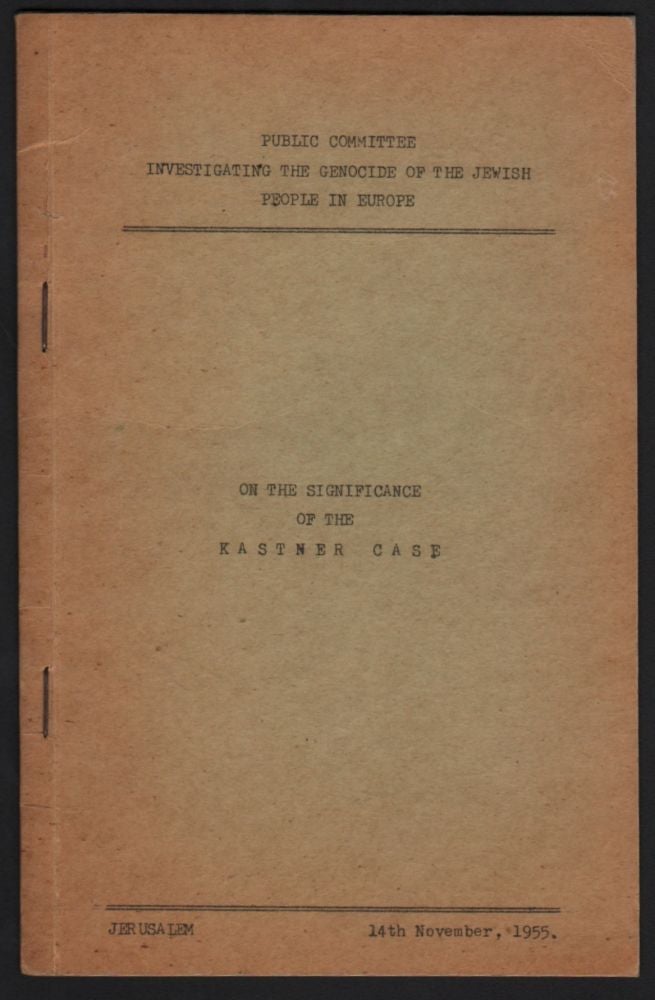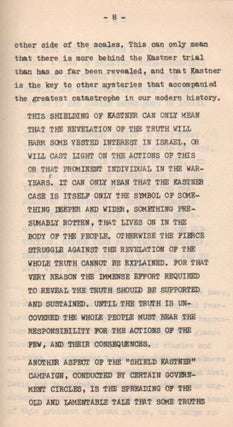On the Significance of the Kastner Case.
Jerusalem: (S.n.), November 14, 1955. First edition. Mimeographed typescript. In original cardboard wrappers. (1), 13, (1) leaves. In fine condition.
Extremely scarce pamphlet, uses the Kastner case as a weapon to attack the Attorney General of Israel, the governing Mapai party, and the entire Government of Israel. The Kastner case was one of the greatest political scandals of Israel in the 1950s, that led to the resignation of the Prime Minister Moshe Sharett and the collapse of his cabinet.
The brochure delineates the Kastner case, and uses the trial’s (The Attorney-General of the Government of Israel versus Malchiel Gruenwald) verdict against Kastner to question the independence and neutrality of the Attorney General of Israel who did not put Kastner on trial, and also the righteousness of the Government that is “prepared to sacrifice even the sanctity of the Courts in its desire to shield Kastner”, and goes even further, saying that “this shielding of Kastner can only mean that the revelation of the truth will harm some vested interest in Israel, or will cast light on the actions of this or that prominent individual in the war-years.”
It was issued by the “Public Committee Investigating the Genocide of the Jewish People in Europe” made up mainly of members of the right-wing, nationalist Herut party and revisionist Zionists, to investigate the actions of Jewish leaders during the Holocaust, however they were not that active in any other cases but this one.
The Committee used the “Israeli Nazi and Nazi Collaborators Law” and the ongoing Kapo-trials as a basis for an a fortiori argument against Kastner by stating that he “was not a petty kapo but the leader, or one of the leaders, of Hungarian Jewry during world war II”.
The text goes through the entire affair, starting the Gruenwald-newsletter in 1952, the allegation made by Melchior Gruenwald, which was the trigger of the Kastner case. In his “Letter to Friends in the Mizrachi” Gruenwald accused Kastner “with behaviour and actions that facilitated the destruction of Hungarian Jewry, with top-level collaboration with the Nazi Occupiers of Hungary in 1944, and giving testimony in favour of a Nazi war criminal and thus saving him from the punishment due to him”. As a response to the “Letter” the Israeli government sued Gruenwald on Kastner's behalf. The judge ruled in Gruenwald’s favour, found that Kastner had collaborated with the Nazis, and his motive was to “save a small number of Jews including his relatives and colleagues, he had knowingly facilitated the destruction of the rest of Hungarian Jewry”. Beside this Kastner “had engineered the surrender to the Nazis of two parachutists sent from Palestine to organize resistance”; had failed to intervene for the life of the third, the legendary Chana Senesh (Hanna Szenes); given false testimony in the case of Kurt Becher during the Nuremberg trials, thus allowing him to escape prosecution for war crimes. Benjamin Halevy, the judge accused Kastner of having “sold his soul to the devil”. This part is followed by the allegation of the Attorney General and the Government.
Rudolf Israel Kastner (or Rezső Kasztner; 1906–1957) was a Jewish-Hungarian journalist and lawyer, who helped Hungarian Jews to escape the Holocaust during the German occupation of Hungary. He was one of the leaders of the “Aid and Rescue Committee” (Budapest Jewish Rescue Committee), the “Vaada” (Va'adat Ha-Ezrah ve-ha-Hatzalah be-Budapesht), in this position he negotiated with Adolf Eichmann to allow 1,684 Jews to leave to Switzerland instead of being deported to Auschwitz, on 35 cattle trucks, what became known as the Kastner train, in exchange for money, gold and diamonds.
After the war Kastner moved to Israel, becoming a spokesman for the Ministry of Trade and Industry. In 1953 he was accused by Malchiel Gruenwald of having been a Nazi collaborator in a self-published pamphlet. The Israeli government sued Gruenwald for libel on Kastner’s behalf, but the judge ruled in Gruenwald favour. His decision led to the collapse of the Israeli Cabinet and Kastner also resigned his governmental position. In early March 1957 he was shot as he arrived at his Tel Aviv home, he died of his injuries two weeks later. The attack was carried out by a three-man squad of veterans of the pre-state right-wing militia, the Lehi. The Supreme Court of Israel overturned most of the judgements in January 1958, stating that the lower court had “erred seriously”. Recently documents relating to the assassination has been released that confirm that Israel's internal security service, the Shin Bet was involved in the murder of Kastner.
Very less is known about the “Public Committee Investigating the Genocide of the Jewish People in Europe”. The Secretary General of the Committee was Jeremiah Halpern (1901–1962) and the presidium consisted: Joseph Klausner (1874–1958), Joseph J. Rivlin (1889–1971); Joseph Schechtman (1891–1970), Isaac Levinson (1896–1971), formerly all of them were associates of Ze'ev Jabotinsky, Halpern as his aide de camp in Haganah, Levinson as his secretary. Jabotinsky’s legacy was carried by the Herut party.
Extremely scarce, we could trace only one copy worldwide.
.
Price: €1,800.00



